 Now that our 20-foot timeline for “Ten Decades of the Trinity Tripod” has been installed, we can finally open this exhibition!
Now that our 20-foot timeline for “Ten Decades of the Trinity Tripod” has been installed, we can finally open this exhibition!
The Watkinson Library invites the campus community to our opening during Common Hour (12:15-1:30) on Tuesday, October 6th, 2015. We will have light refreshments, and the event for the hour will be a running game of Trin-Trivia, a game devised by Head Curator Rick Ring to test your knowledge (and teach you a little something) about Trinity College history.
For those who show up and play, you will be able to win a “vintage” edition of the Tripod, or other cool bits of Trinitiana!
Comments Off on Exhibition opening
This week saw a rare happening in the Watkinson: two presentations using the exact same materials for separate classes at separate institutions!
 On Monday night, profesor Scott Gac (Trinity) brough his HIST 354 class in to look at materials related to slavery in the Watkinson, which included a set of slave shackles recently donated to us, two manumission documents, and two bills of sale for slaves.
On Monday night, profesor Scott Gac (Trinity) brough his HIST 354 class in to look at materials related to slavery in the Watkinson, which included a set of slave shackles recently donated to us, two manumission documents, and two bills of sale for slaves.
 On Tuesday night, professors Bryan Sinche and Sarah Senk (University of Hartford) brought the students in a Senior Capstone Course to look at the very same items, with the addition of published slave narratives and publications of the American Colonization Society–including our very fragile issues of The Liberia Herald.
On Tuesday night, professors Bryan Sinche and Sarah Senk (University of Hartford) brought the students in a Senior Capstone Course to look at the very same items, with the addition of published slave narratives and publications of the American Colonization Society–including our very fragile issues of The Liberia Herald.
Comments Off on A teaching two-fer
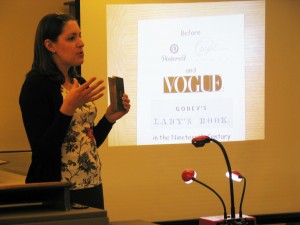 I’d like to give a shout-out to our wonderful NERFC Fellow Amy Sopcak-Joseph, a PhD candidate (History) at UConn, who gave a well attended lunch-time talk in the Watkinson on Tuesday entitled “Before Pinterest, Oprah, and Vogue: Godey’s Lady’s Book in the Nineteenth Century.” In her own words:
I’d like to give a shout-out to our wonderful NERFC Fellow Amy Sopcak-Joseph, a PhD candidate (History) at UConn, who gave a well attended lunch-time talk in the Watkinson on Tuesday entitled “Before Pinterest, Oprah, and Vogue: Godey’s Lady’s Book in the Nineteenth Century.” In her own words:
Have a question about how to style your hair? Need a recipe for something healthy? Want recommendations for interesting new books? Or where you should buy new clothes and shoes? Twenty-first century American women have the answers to these questions and more at their fingertips. In the nineteenth century, most women turned to one source for all of these items: Godey’s Lady’s Book. Published by Louis Godey in Philadelphia from 1830 to 1877, this monthly magazine arrived in the homes of hundreds of thousands of women to answer these needs, and more. This talk explores how Godey adapted his marketing of and the advertisements in his Lady’s Book to women’s changing tastes prior to the Civil War. The ads in the magazine initially encouraged far-flung readers to purchase more reading materials, while Godey enticed readers with fiction by famous authors. By the 1850s, readers received fashion plates sponsored by retailers, could order fashionable goods directly from Godey, and could even purchase Godey-branded sewing needles. At the same time, Godey advertised his magazine as “Useful, Ornamental, and Instructive,” promising women recipes, clothing patterns, and tips for healthy living that would save them money.


Comments Off on Thanks to our NERFC Fellow!
[Associate Curator Sally Dickinson attended a recent event opening the Wadsworth Atheneum after a long period of renovation. Some of our books are featured in their exhibition.]
The evening began with a walk up the red carpet to the Wadsworth Atheneum’s opening celebration for its “museum family.” The cause was the completion of a 5-year renovation and reinstallation of its impressive collections of European art. Shown here is the Watkinson’s contribution to the Cabinet of Art and Curiosities: Konrad Gesner’s Historiae Animalium (1617,) Johann Gottfried’s Newe Welt und Americanische Historien (1655) and Joannes Jonstonus’s Historiae naturalis (1657). The books were selected by Atheneum curator Linda Roth. A personal favorite is the engraving of a unicorn. The gallery was visually arresting. Picture natural history specimens, painting, and decorative arts informing one another. The installation (puffer fish mounted about the door, drawers of manuscripts and portraits, etc.) was as remarkable as the art itself. This show is one not to miss. Link to the New York Times review.



Comments Off on We lent some cool stuff for their party!
[Posted by Peter Rawson, Associate Curator of Archives & Manuscript Collections]
 While conducting a survey of the archives I came across two 19th-early 20th century collections.
While conducting a survey of the archives I came across two 19th-early 20th century collections.
The first are the papers of the Reverend Frederick William Harriman, D.D, Class of 1872. Harriman served for over thirty years as the rector of Grace Episcopal Church in Windsor, CT, retiring in 1920. The collection contains several of his hand-written sermons, information pertaining to his father, the Reverend Frederick Durbin Harriman, Class of 1845, personal correspondence, and family genealogy.
The second are the papers the Reverend Abner Jackson, Class of 1837, and eighth President of Trinity from 1867-1874. The papers contain three of his diaries from 1860-1864, personal correspondence, 1840-1874, certificate of ordination as a priest by Bishop Brownell (first President of Trinity), and a published volume of his discourses, 1875.
Both of these collections give us insight into Trinity’s early roots in the Episcopal Church, and the lives and perspectives of members of our community in the 19th and early 20th centuries.
Comments Off on Re-discovering the archives!
Posted by: rring in Gifts
 What appears to be a 17th century collection of poetry–apparently the commission was not completed, as tere are some blank spaces for miniatures and other ornaments.
What appears to be a 17th century collection of poetry–apparently the commission was not completed, as tere are some blank spaces for miniatures and other ornaments.


Comments Off on Persian gifts, part 3
Posted by: rring in Gifts
Comments Off on Persian gifts, part 2
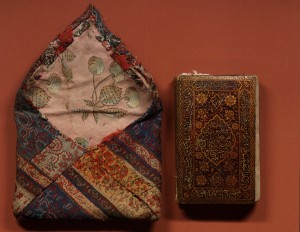 From a family in Litchfield, CT who have been giving rare books (for literally generations) to Trinity College, we have received a few absolute gems!
From a family in Litchfield, CT who have been giving rare books (for literally generations) to Trinity College, we have received a few absolute gems!
A small Qu’ran, dated 1805, with the fabric pouch into which it was placed, to be hung round the neck, near the heart of the devotional reader.


Comments Off on Persian gifts part 1
[Posted by Ashley Bissonnette, visiting researcher]
As Senior Researcher at the Mashantucket Pequot Museum & Research Center (Mashantucket, Connecticut) currently involved in Battlefields of the Pequot War and Battlefields of King Philip’s War, I recently made a visit to Trinity, which has been significant. The library currently preserves the only known original manuscript of any Pequot War (1636-1637) narrative! The narrative was authored by Lieutenant Lion Gardiner, commander of Fort Saybrook during the Pequot War, in 1660 entitled Relation of the Pequot Warres.
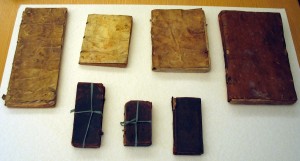 The archives also house the original medical accounts of Gershom Bulkeley, doctor for colonist troops during King Philip’s War (1675-1676). “Gershom Bulkeley Coll. Box 1” contains information on the symptoms and treatment for many epidemical diseases in17th century New England – many of which changed the course of these early colonial battles and heightened the effect of conflict on Colonial and Native peoples alike.
The archives also house the original medical accounts of Gershom Bulkeley, doctor for colonist troops during King Philip’s War (1675-1676). “Gershom Bulkeley Coll. Box 1” contains information on the symptoms and treatment for many epidemical diseases in17th century New England – many of which changed the course of these early colonial battles and heightened the effect of conflict on Colonial and Native peoples alike.
Many thanks to the Watkinson staff for all their help in my research endeavors!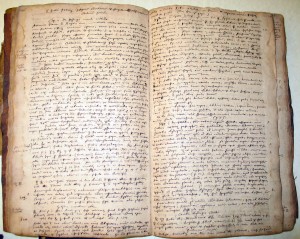
Comments Off on Pequot medicine
 On Tuesday, a dozen first-year students participating in the Bantam Beginnings program came to the Watkinson Library to look at several rare books featuring anatomical illustrations from the 16th-19th centuries. Each student was to select a particular organ, system, etc. and compare how early anatomical illustrations compare to 21st century depictions. This was part of The Skill in Observation and Communication in Art and Medicine program, facilitated by Professor William Church.
On Tuesday, a dozen first-year students participating in the Bantam Beginnings program came to the Watkinson Library to look at several rare books featuring anatomical illustrations from the 16th-19th centuries. Each student was to select a particular organ, system, etc. and compare how early anatomical illustrations compare to 21st century depictions. This was part of The Skill in Observation and Communication in Art and Medicine program, facilitated by Professor William Church.
We had set out 9 books, all open to anatomy illustrations. The students were not only engaged with the material, but also asked many questions—both about content and the books themselves. In several cases, the students asked for dictionaries to look up terms that they didn’t understand instead of turning immediately to the internet for answers. The class was with us for about an hour with the students congregating around several of the texts, carrying on discussions about the content that ranged from questions about the images: “What is that?” “Is that a hip?” “What part of the brain is that?” “Are those lines veins coming out of the muscles?”
 They were also curious about the way the images were depicted—questioning the artistic merit/content/liberties—and asking if the images were typical of anatomy books, or of iconography found in art of the period. One of the more interesting conversations that seemed to stem from the images was how the bodies for dissection were obtained. When one of the students realized that the bodies were often of the poor, lower classes, or prisoners, she took another look at the muscles that were depicted on the skeleton and said; “Then I guess he wasn’t the most muscular specimen that they could find!”
They were also curious about the way the images were depicted—questioning the artistic merit/content/liberties—and asking if the images were typical of anatomy books, or of iconography found in art of the period. One of the more interesting conversations that seemed to stem from the images was how the bodies for dissection were obtained. When one of the students realized that the bodies were often of the poor, lower classes, or prisoners, she took another look at the muscles that were depicted on the skeleton and said; “Then I guess he wasn’t the most muscular specimen that they could find!”
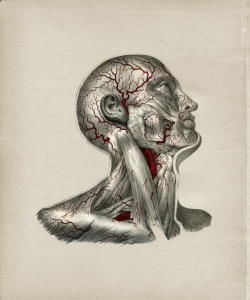 Students were particularly fascinated by illustrations in A series of anatomical plates; with references and physiological comments by Jones Quain and W.J. E. Wilson, published in 1842. This work stimulated many questions about specific organs and systems. Also of great interest was the classic work Medici De humani corporis fabrica libri septem : Cum indice rerum & uerborum memorabilium locupletissimo, by Andreas Vesalius, published in 1568.
Students were particularly fascinated by illustrations in A series of anatomical plates; with references and physiological comments by Jones Quain and W.J. E. Wilson, published in 1842. This work stimulated many questions about specific organs and systems. Also of great interest was the classic work Medici De humani corporis fabrica libri septem : Cum indice rerum & uerborum memorabilium locupletissimo, by Andreas Vesalius, published in 1568.
[Posted by Watkinson staff Henry Arneth & Peter Rawson]

Comments Off on Name that body part!
 On Monday night, profesor Scott Gac (Trinity) brough his HIST 354 class in to look at materials related to slavery in the Watkinson, which included a set of slave shackles recently donated to us, two manumission documents, and two bills of sale for slaves.
On Monday night, profesor Scott Gac (Trinity) brough his HIST 354 class in to look at materials related to slavery in the Watkinson, which included a set of slave shackles recently donated to us, two manumission documents, and two bills of sale for slaves. On Tuesday night, professors Bryan Sinche and Sarah Senk (University of Hartford) brought the students in a Senior Capstone Course to look at the very same items, with the addition of published slave narratives and publications of the American Colonization Society–including our very fragile issues of The Liberia Herald.
On Tuesday night, professors Bryan Sinche and Sarah Senk (University of Hartford) brought the students in a Senior Capstone Course to look at the very same items, with the addition of published slave narratives and publications of the American Colonization Society–including our very fragile issues of The Liberia Herald.























